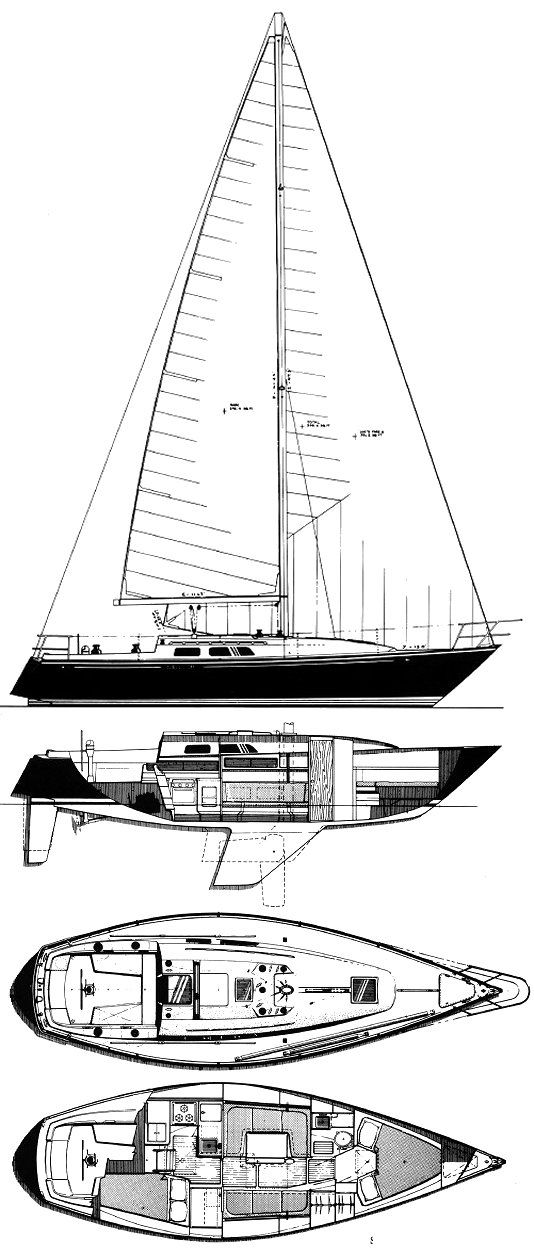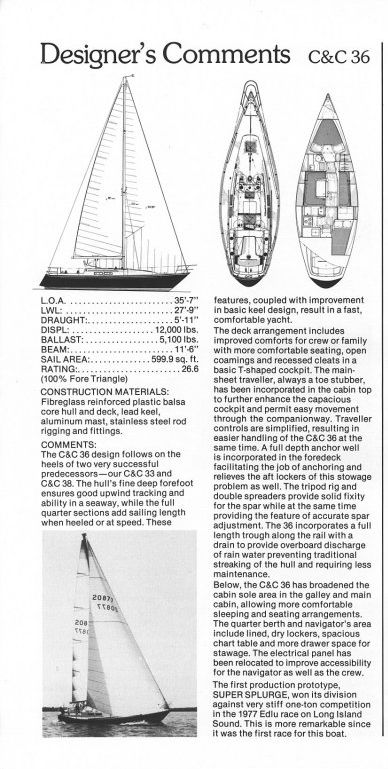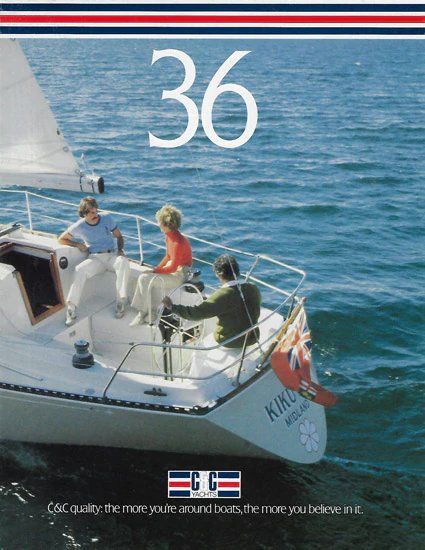


C&C 36
LOA: 35' 8” LWL: 27' 9"
Yacht Names
Selah,
Chamamé - Reflection - Cirrus
DWG #
76-6
2008.0012.0026 (1-4),
2008.0012.0096 (1-4),
2008.0012.0094 (1),
2008.0012.0084 (1-3),
2008.0012.0132 (1),
2008.0012.0159 (1-3),
2008.0012.0093 (1)
2001.0066.0172.0001,
2001.0066.0172.0002,
2001.0066.0172.0003
Designer / Draughtsman
C&C Design Group,
"Killing, Steve : SK",
"Mazza, Rob : RM",
"Kelly, Bruce",
Project Manager
"Mazza, Rob : RM"
Year of Design
1976
Builder
C&C Yachts Limited
Other People
"Rutherford, Tim"
Notes
Perry Design Review:
C&C 36 C&C continues its production of beautifully styled boats.
By Bob Perry
August 25, 2000
This review gives us the opportunity to compare C&C's latest 36-foot offering, which is actually a progression of the C&C 34+, with the 1975 vintage C&C 36. Both boats share good looks. The old C&C 36 shows a deck that is typical of vintage C&C designs, with a shapely trunk fairing into a rounded bullet shape as it goes forward. The new 36 shows an exquisitely sculpted trunk, far more dramatic than the older 36, but with the same basic character. The hulls share some numbers in addition to similar LOAs.
Both boats weigh 12,000 pounds and have beams within an inch of each other at 11 feet, 6 inches and 11 feet, 7 inches. The biggest difference in basic dimensions is at the DWL. The old 36 had a DWL of 27 feet, 9 inches, and the new 36 has a DWL of 30 feet for an additional 2 feet, 3 inches. This extra DWL brings the D/L down from 251 to 198.4. The plan view shows that while the beams are similar, the distribution of beam is distinctly different. The old 36 was still trying to keep its measured IOR length down with what we came to call "pinched ends." The new 36, on the other hand, has an extremely broad stern.
Looking at the rest of the hull shape, I can see a strange little kick to the counter profile aft. Generally, you like to keep the run and counter as flat as possible. Both hulls show small skegs in front of the rudders, but the newer 36 has a vertical rudder stock and a rudder that cuts off at the DWL and doesn't meet the counter. The keel of the new 36 shows that we have come to fins with bulbs from the days of the old 36 when keels were bladelike fins. People want horsepower and you need stability to carry a big rig. The best way to increase stability is to put some type of bulb on the keel. Interestingly, the older fin-keeled 36 had 400 pounds more ballast than the newer fin-keeled model. There is also a wing keel, shoal draft model with 4 feet, 11 inches of draft and 5,225 pounds of ballast. Going below we see dramatic differences between the two boats. The arrangement plan differences are as marked, if not more marked, than are the hull shape differences. The old 36 is very typical of the layouts of the day, very boxlike with lots of 90-degree angles. The quarter berth of the old 36 is a double in the new 36, hinting at things to come. The new 36 has a layout developed from the years of influence the European designs have had on us, such as the queen-sized quarter berth in its own separate stateroom. This puts pressure on the galley, so the new 36 has less counterspace. The head on the new boat is aft and includes a shower stall. The nav station is coupled to the starboard settee. Forward V-berths are history, and the new 36 has a large double berth forward. Progress is wonderful. I would also like to know how much the layout had to do with the width of the stern on the newer design. I'm partial to the older layouts, but that's just me trying to hold on to the things I loved about boats as a boy. Interiors are so subjective.
You can choose from three different rigs for the new 36: the 36+ for cruising, and the 36XL or 36R for racing. The difference among them is horsepower, with an SA/D on the hottest model — the 36R — of 20.94, compared to the 18.31 on the original 36 (which was considered relatively high at the time). The new rigs have triple spreaders and running backs. The old chopped-off E dimension so typical of the IOR has been replaced with a boom that can sheet to the aft end of the cockpit. The sailplans show this to be an exceptionally handsome design in every respect. https://www.boats.com/reviews/perry-design-review-campc-36/ C&C 36 BW StaffJuly 1, 1989 — No Comments ↓ Author: BoatingWorld Staff When Tom West went shopping for his dreamboat, he had an advantage not many of us have: airline passes. Tom is a commercial pilot, and free travel on various airlines is one of the perks of his job. Anyway, itinerant Tom flew to the major boat shows around the country, from Seattle to Annapolis, from Miami to Newport. He poked around all sorts of new sailboats. He endured scores of windy sales pitches. And he listened, not just to the salesfolk, but to boat owners at the shows. " I was about ready to buy a 30-footer from a major builder when I happened to run into the CEO of the company at the Annapolis show," Tom recalled. "As we were chatting about the boat’s virtues, an irate owner spotted the CEO and broke into the conversation. He proceeded to give the guy an earful about leaks, misaligned prop shafts, and on and on. It put me off that boat in a hurry." So Tom continued his quest. Then, at the New York show he found the boat, a C&C 30."As a pilot, I was particularly concerned about a boat’s structural integrity. When you’re in the air or at sea, you don’t cut corners with safety. And in that respect, I was very impressed with the C&C," Tom said. He was even more impressed after he used another of his airline passes to visit the C&C factory in Niagara-on-the-Lake in Ontario, Canada. "I was ready to give up flying and become a boat builder. Those guys at C&C are real craftsmen. Everyone there looked like they had been building boats all their lives" Well, maybe not that long.
But Cuthbertson & Cassian, named for the company’s co-founders, has been turning out one acclaimed model after another for two decades now. In fact, C&C celebrates its 20th anniversary in September. The company’s work force is unusually stable. Many workers have been with C&C for 15 years or more. Despite the company’s relatively long history, C&C boats aren’t exactly chock-a-block in West Coast marinas. The company has been able to sell all it can build in its own backyard: that is, on the Great Lakes and on the Eastern Seaboard. But as Bill Forsythe, owner of Yacht Connection in Newport Beach and a C&C aficionado, pointed out, C&C’s designs are made to order for West Coast sailors. " Sailors here have no interest in shoal drafts, swing keels and split rigs. They reject austere, formica interiors. They want high performance sloops or cutters with attractive interiors that can sail well in a variety of conditions. And that’s what C&C builds."
C&C boats are squarely aimed at the high end of the sailboat market. They’re designed, by the company’s respected in-house C&C Design Group, with an emphasis on performance. They’ve built strong. And they’re expensive. Pound for pound, they’re considerably higher priced than other popular, similar-sized boats. And what do C&C buyers get for their money? Attention to detail: myriad details, many invisible to all but an experienced sailor or marine surveyor. " C&C boats generally show better detailing," said Clark Barthol, a surveyor based in Mar Vista, California. " For instance, they have proper bedding compounds and backing plates for hardware. Their gelcoat work is good. And instead of having the smallest size fastenings necessary, they’ll have a step above.â â C&C’s have impressive detail for production boats," agreed Fred Lynch, a surveyor with Admiralty Marine in Newport Beach, California. " When you look in the deep recesses of a C&C’s hull, places where people at boat shows don’t see, you find neatly finished seams, not globs of resin." " C&C designers obviously give a lot of thought not only to how their boats look at the boat show dock, but about ease of maintenance years later," said Peter Britton, a surveyor from Fountain Valley, California. " C&C’s machinery and electrical systems are laid out so you can actually work on them, unlike other boats I come across" If those endorsements of C&C quality aren’t enough, consider a few construction details of the C&C 36. Some 270 C&C 36s were built from 1977 through 1981, and the model is typical of C&C’s midrange designs.
The C&C Design Group is quick to embrace high-tech materials: The company claims to have been the first major sailboat builder to use balsa-cored hulls for added stiffness and insulation, and now Kevlar in the new C&C 34 and 37 models. The 36’s hull and deck/cabin are separately molded structures of balsa-cored fiberglass. Alternate layers of mat and roving were hand laid, with extra roving used to reinforce hull sections subjected to particular stress. The keel is made from lead with a bit of antimony added for extra strength. It is attached to the hull with stainless steel bolts that are accessible for tightening later in the boat’s life. And after it is attached, the keel is carefully faired to the hull: a nice, custom boat touch. C&C is particularly proud of its spars, rigging and hull-to-deck joint work. The latter is a through bolted lap joint with three layers of sealer, all capped off by an anodized aluminum toe rail. The 36’s C&C-designed mast has a well rounded leading edge, and is completely supported by Navtec rod rigging. Rod rigging, though more expensive, is stronger than wire rigging and thinner too, for less windage. The masts on C&C boats are also stepped on the keel, not just on the deck. The interior consists of separately molded modules for the forecastle, head, saloon and galley/navigation/quarter berth. A separately molded headliner has plenty of removable inserts for access to wiring and deck mounted hardware.
OK, so C&Cs are thoughtfully designed and well made. But can they sail? With the best of them. It was the abiding philosophy of co-founder Cuthbertson that race boats and cruising boats aren’t mutually exclusive. " He believed a high performance boat is an easier boat to sail, even when cruising," said Neal Esterly, San Diego’s dealer. " A boat that tracks well requires less intense concentration. A boat that goes to weather well requires less tacking. A fast boat gets you where you’re going sooner, which can be safer if you’re trying to outrun bad weather. It all adds up to a boat that’s less tiring and more fun to sail." Toeing to that line, the C&C Design Group has consistently turned out quick boats, be they custom one-off racers such as Red Jacket or Sorcery or C&C’s bread and butter production sailboats. The production boats usually evolve directly from the race boats. Consider the 36’s configuration: It has a shallow rounded bottom with low wetted area, a swept back deep fin keel, a moderately swept back rudder and a reverse transom. Definitely the stuff of racers. And the C&C 36 sails quite like a racer too. In a Sea Trial for the August 1977 issue, the article said," Sailing tests of the C&C 36 gave it an unqualified thumbs up! Easy to control off the wind, quick on its acceleration in puffs of wind, and a well-balanced helm made sailing a pleasure" In fact, the Sea Trial boat had taken first place honors against One Ton boats designed by Peterson, Holland and Hood in a 125 mile race on Long Island Sound the day after its launching. But like other C&Cs, the 36 is a family cruiser too.
The 36 was especially beamy for its day, and its designers made the most of it. They put in a double quarter berth, a nav station, a U-shaped galley, a U-shaped dinette, a settee, forward V-berths and a head compartment. To be sure, the C&C 36, like most C&C production boats past or present, is no long distance voyager. It’s not that its hull isn’t up to the rigors of blue water, it’s just that the tank only holds 40 gallons of water and 20 gallons of fuel. Its head compartment, though adequate, is small and the galley lacks enclosed storage space for much more than a good supply of hors d’oeuvres. Instead, the 36 is a fast coastal cruiser designed for the way most of us use our boats.
https://www.boatingworld.com/boattests/c-c-36/
Number Built
270 ish
Brochure
https://boatbrochure.com/products/c-c-36-brochure?_pos=1&_sid=15e34d207&_ss=r
Web Link
https://sailboatdata.com/sailboat/cc-36-1
Gilbert Moulds
C&C 36, C&C 36, C&C 36D deck
All rights reserved. Motion Designs Limited
© 2022
We need your consent to load the translations
We use a third-party service to translate the website content that may collect data about your activity. Please review the details in the privacy policy and accept the service to view the translations.